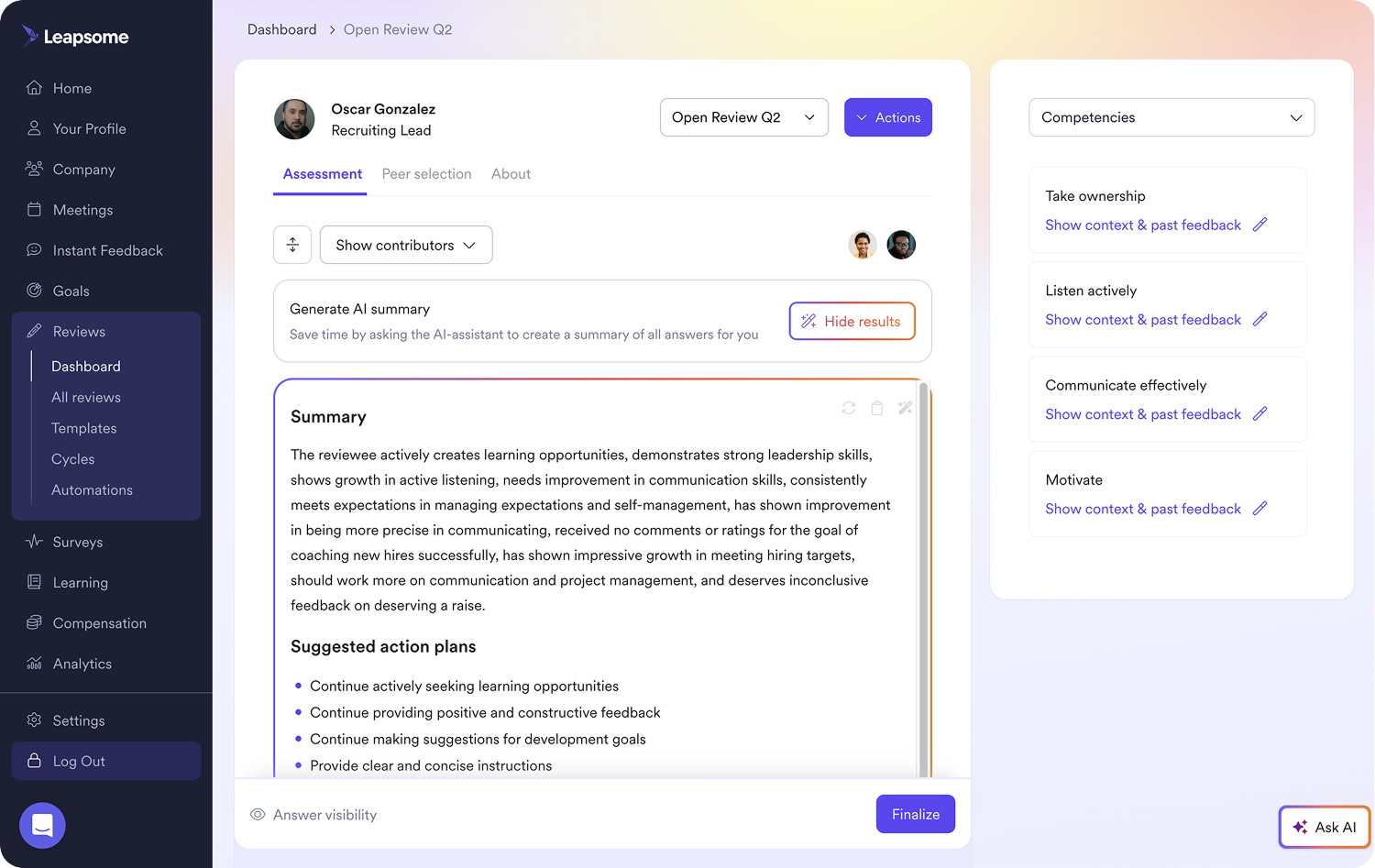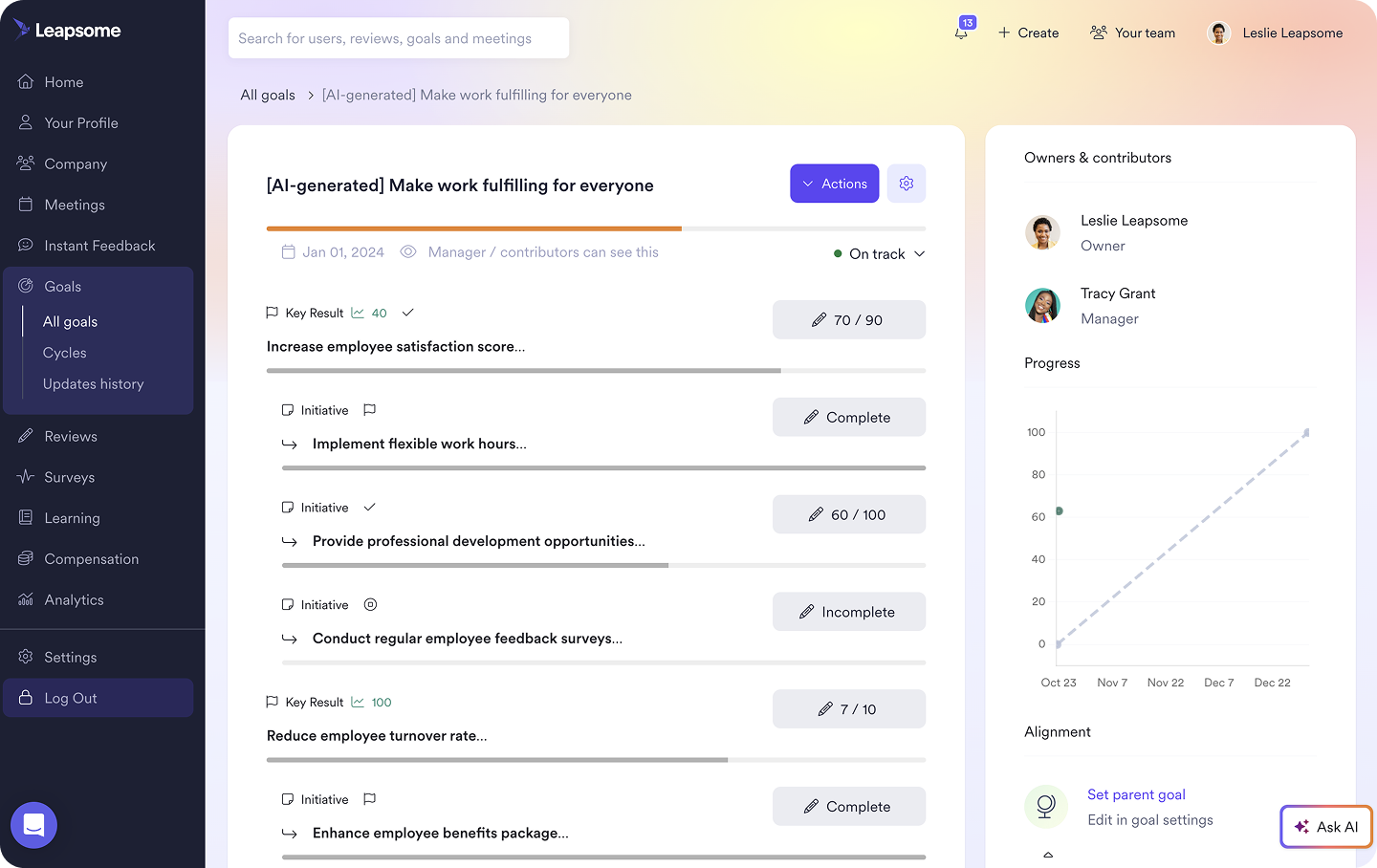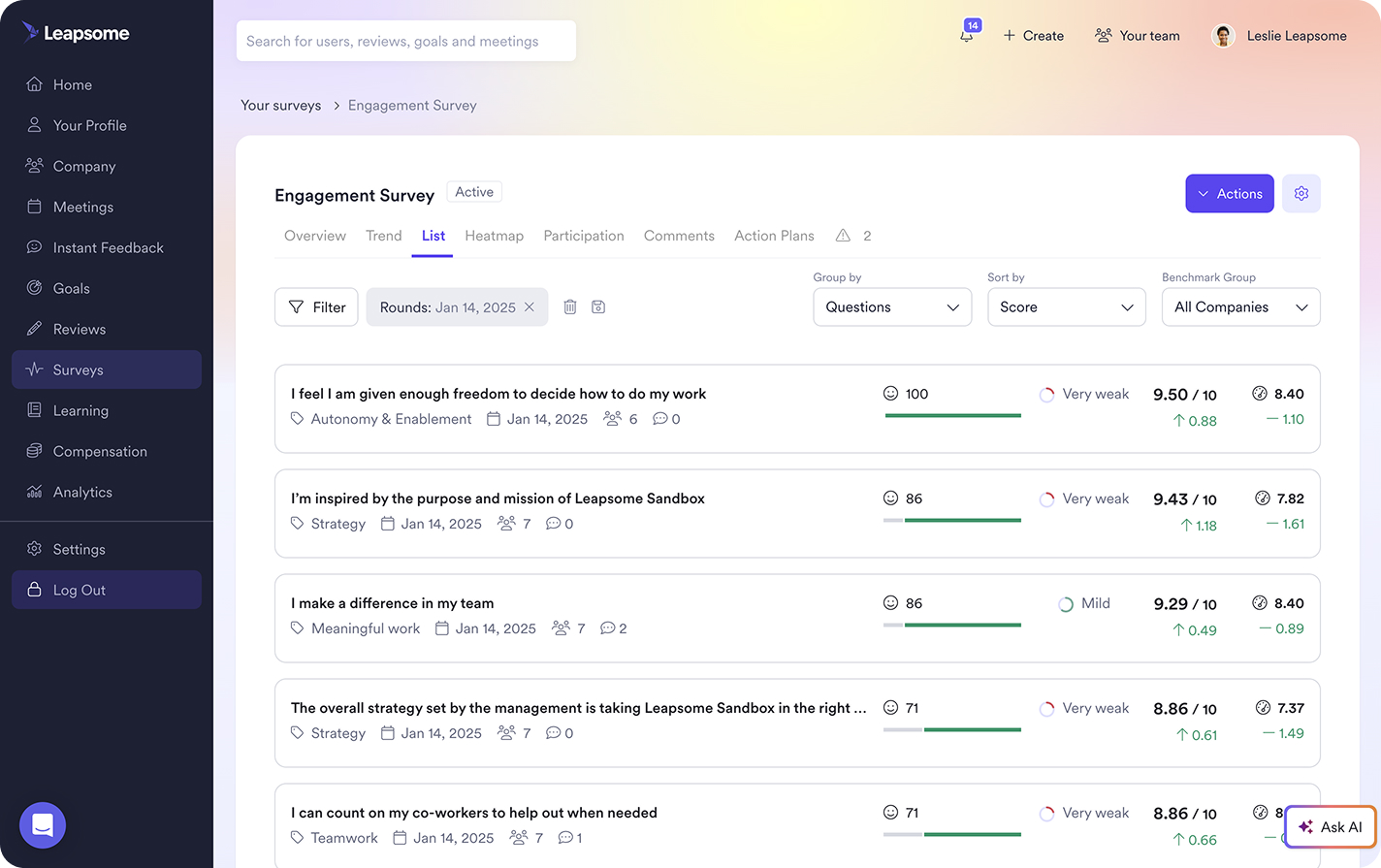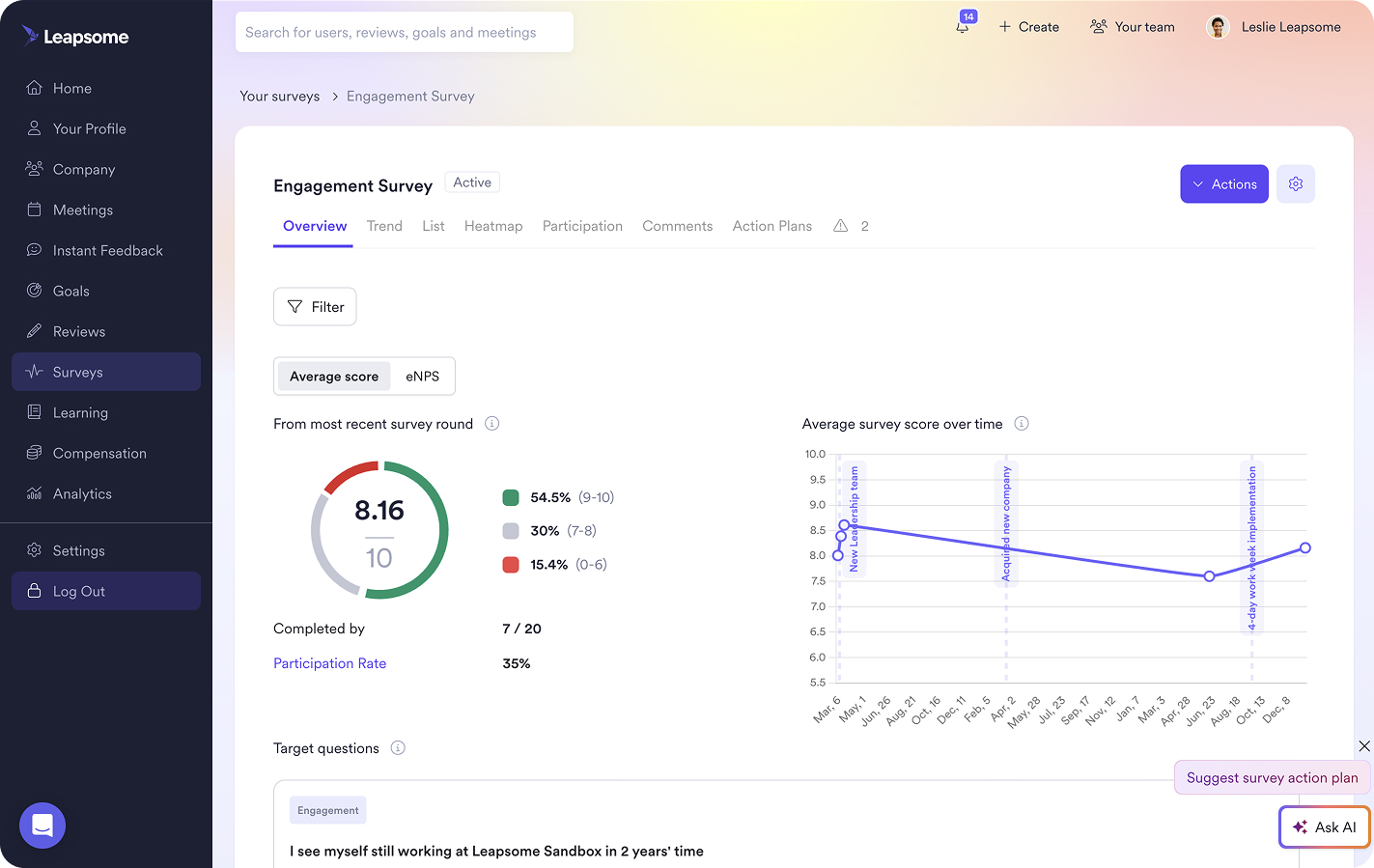6 steps to create an employee engagement plan (+ free template!)

As companies acknowledge the benefits of employee engagement, they are moving toward a development-focused, coaching-inspired approach to people management. Moreover, organizations are leveraging tech to make processes more efficient. According to our State of People Enablement Report, 84% of HR leaders use people enablement software to improve their management processes, and 97% say this has made a positive impact. (1)
It’s good news that more organizations are investing in processes and people tech as a long-term growth strategy. Still, there’s a disconnect worth acknowledging: Fewer than one in three employees say they feel completely engaged with their work (but HR leaders estimate the amount to be over 50%). (2)
Companies that recognize this inconsistency often rush to reinvent the employee experience wheel in an attempt to reduce turnover and increase retention. But without a solid employee engagement plan, they risk doubling down on outdated processes and putting more pressure on already stressed-out management to drive results.
But it’s not all doom and gloom: If your organization has an established system for measuring employee engagement and gathering employee feedback, you’ve won half the battle. All that’s left is putting your data to work with an impactful engagement plan. This article will guide you in creating your own by discussing the best practices leadership and managers must follow to get their action plans off the ground. We’ve also included a free, customizable template you can download to get started.
Our free employee engagement plan template
Our employee engagement strategy template is ideal for any HR leader, people ops professional, or manager who has never created an engagement plan from scratch. It offers dedicated spaces for you to record areas for improvement, note down suggested initiatives, create a time frame, and assign project ownership and success metrics.
It’s completely customizable, so you can get as granular or high-level as you need to. Best of all, a template like ours makes it easy to share your strategy with leadership and other stakeholders you need to get on board.
Check out our engagement plan examples below to see how this can look in action.
.webp)
Our template simplifies the process, enabling you to focus on what truly matters: developing your people.
🚀 Create a data-informed engagement plan with Leapsome
Our free, customizable template gives you a centralized place to strategize and document your engagement efforts.
👉 Access the template
What is an employee engagement plan?

Use Leapsome Reviews to generate AI-powered summaries and action plans, making it easier to reflect on feedback and support employee growth
An employee engagement action plan outlines the steps you must take at the company, team, and individual levels to solve issues identified via employee feedback or boost your overall engagement. If team members continuously report the same issues — like intense workload or lack of training and development — it’s probably time to implement an action plan. HR/people ops leaders and employees, as well as managers and team leads, can all collaborate to implement impactful actions.
Suppose several employees across different teams report a lack of autonomy over their projects. Once department leads are aware of this feedback, they might enlist HR’s help to develop initiatives with a time frame for completion and performance metrics for greater follow-through. Ideas may include implementing a management training program or developing a set of operating procedures and uploading those to the company’s knowledge base for easy employee reference.
💡 You can’t build an action plan without knowing your people! And for that, you need engagement surveys.
Running employee engagement surveys with Leapsome means backing your surveys with scientific research, state-of-the-art analytics, and expert guidance on action plans.
Our survey tool also lets you track changes in engagement levels with indicators like the Employee Net Promoter Score (eNPS).
Why create an employee engagement action plan?

Creating an engagement plan for employees is necessary for any organization struggling to balance its tech processes with a people-centered management approach.
If this describes your business, you’re not alone. The number of tech solutions for people management and dispersed work setups has brought as much disruption to the employee experience as it has simplicity. But it doesn’t have to be that way.
“Technological advancement, most notably the profusion of technologies powered by generative artificial intelligence, is creating the potential for new ways of working that can help elevate human performance (outcomes for both organizations and workers).
“To deliver on these outcomes, organizations will need digital playgrounds — safe spaces that encourage intentional play and curiosity — to experiment and explore new ways of working. Safety in this context refers to psychological safety — where individuals don’t risk punishment or humiliation for speaking up with ideas, questions, concerns, or mistakes, and where they are safe to take interpersonal risks. It also refers to spaces where workers can experiment with new processes and technologies without putting business outcomes at risk.” — How play and experimentation in digital playgrounds can drive human performance, Deloitte, 2024
Creating a people-focused employee engagement action plan is crucial to creating this kind of psychological safety. It also acts as a first step to help organizations:
- Keep everyone committed to engagement — An employee engagement action plan holds team members, managers, and executives accountable for improving engagement.
- Increase the ROI of employee engagement — Engaged team members are more resilient and productive; they also have fewer absences and are less likely to quit their jobs.
- Measure employee engagement progress more accurately — An action plan should detail key engagement drivers, milestones, and benchmarks and let you gauge the success of your engagement initiatives.
- Improve employee experience and boost morale — Taking action on your survey results shows employees that their feedback matters, preventing discontent and “survey fatigue.”
6 steps to creating an employee engagement action plan
If you suspect that employee engagement is low at your company, you need survey-backed data to help you determine what needs improving — and how you should go about doing so. Let’s look at the steps you should cover in your action planning process:
1. Define your goals

Leapsome Goals makes it simpler to set company-wide engagement goals that you can cascade and share for every departmen
To ensure your employee engagement surveys yield specific and actionable data, determine the goals you want to focus on before you work on the questionnaires.
Clear goals make it easier to create an action plan and produce better survey results, showing employees how effective surveys can be as internal feedback tools.
For instance, you may want feedback on how employees feel about your current performance review process. Do they think reviews happen too infrequently? Or perhaps they’d like more clarity and consistency on your rating scale? Knowing the topics you want to focus on from the get-go will help you choose the right survey questions.
⭐ For remote teams: We recommend using our remote employee survey template to check in with your people about their remote working environment and get a temperature read on how connected and supported they feel.
2. Conduct an employee engagement survey

Identify your main areas for improvement quickly with the Leapsome Surveys’ Impact Drivers feature
Once you’ve locked down the goals you want to focus on, it’s time to put your employee engagement survey questions together. Don’t rush this step — choose your questions thoughtfully and intentionally.
If your company’s current goal is to explore how staff members feel about your employee development efforts, you could include prompts (qualitative questions, not necessarily in question format) in your questionnaire. Here are some examples:
- My job at [company] enables me to learn and develop new skills
- I’m fairly rewarded for my contributions to [company] with pay, promotion, and/or training
- If I do good work, I know it’ll be recognized
Depending on the data you’re looking for (qualitative or quantitative), you can ask employees to answer your questions with a ranking from 1 to 10, with 10 being the most favorable response. You should also include a few open-ended questions to get more insight into the nuances behind your survey responses.
⭐ Increasing survey participation rates
• Don’t surprise employees with a survey. Run your pulse surveys at regular intervals and give staff members a few days to fill them out, so people don’t feel overwhelmed or caught off guard.
• Ensure your surveys aren’t too long, especially if you’re running them frequently. To increase your response rate, avoid sending out long, detailed surveys too often. When creating a longer survey, give employees sufficient time to complete it.
3. Analyze survey results
.jpeg)
Leapsome’s natural language processing tool lets you turn detailed engagement data into an easy-to-understand visualization
Raw survey results won’t get you very far — you must analyze the responses and identify patterns to understand what the data really means.
Start by measuring your employee survey participation; while this metric doesn’t yield nuanced engagement data, it’ll show how open your people are to participating in surveys. You can also compare participation rate with other useful engagement metrics like eNPS and retention rate.
When reading through your results, dig deep and get as granular as possible in your analysis. Uncover the quantitative and qualitative data in your engagement scores and open comments to understand employee sentiments behind the survey responses.
For a more detailed analysis of your quantitative data and open-ended answers, Leapsome’s natural language processing tool can turn your engagement data into visualizations that make it easier to see what your action plan should prioritize. Graphics also simplify sharing your results with other stakeholders. When data is visually digestible, it’s easier to get buy-in for your engagement initiatives.
Our language processing tool also pairs this visual data with actionable insights to help you get started on your initiatives.
4. Decide on your employee engagement initiatives

With Leapsome’s platform for engagement surveys, you’ll have action plan recommendations built right in
It’s time to put your employee survey results! Use your data to structure your engagement action plan around measurable initiatives to improve “problem areas.”
Coming up with actionable steps to boost engagement is your team’s opportunity to get creative and seek advice from experts who have experience creating engagement initiatives.
If you use Leapsome, you can access the best-practice action plan recommendations we’ve built into the platform, personalized according to your company’s survey results!
Some of your action points could include:
- Setting OKRs to boost employee engagement to keep everyone informed about your engagement goals and progress
- Holding “stay interviews” with employees who are at risk of leaving the company
- Helping employees develop their skills with a learning and development tool
- Offering flexible work hours or transitioning to a hybrid work model to increase work-life balance and avoid burnout
5. Establish milestones to monitor progress
Your action plan must include milestones (or success metrics) to help you track the progress of your employee engagement initiatives. Some examples include:
- Increasing survey participation rate by X% in the next six months
- Increasing eNPS scores by X% in the next six months
- Increasing retention by X% in the next year
- Decreasing absenteeism by X% in the next year
- Carrying out [X number] of DEI initiatives by the end of the year
You can also monitor your progress with more short-term, specific, and focused metrics like:
- Holding three “stay interviews” in the next quarter
- Having managers organize professional development meetings with each of their direct reports in the next quarter
- Overseeing a 10% increase in learning course completion by the end of next quarter
⭐ Top tip: Conduct pulse surveys throughout the year to check in with employees about the outcome of your engagement initiatives. That way, you’ll have quick insights to adjust your engagement action plan.
6. Follow up
Having processes to follow up on your action plan helps hold HR/people professionals and other stakeholders accountable for improving employee engagement. You can also check how your engagement initiatives are going during informal chat sessions, 1:1 meetings, and team meetings.
We also recommend following up on employee engagement initiatives with surveys to help track your outcomes.
⭐️ With Leapsome’s Surveys, you can easily interpret survey data with our survey overview dashboard and track scores over time.
Simplify your employee engagement action planning

Leapsome’s survey overview dashboard provides a quick breakdown of engagement survey scores over time
Improving employee engagement starts with a commitment to increasing team happiness. After all, employees are your company’s most powerful creative resource in a world that’s overly focused on using tech to scale at any cost.
Still, putting an employee engagement action plan together often involves managing various moving parts, talking to different stakeholders, and bouncing between tools and software for data collection. Just thinking of that whole process could scare you away — but improving your company’s engagement doesn’t need to be complicated!
Leapsome helps companies and teams create a hub to run engagement surveys, analyze survey data, communicate results, and create action plans for continuous improvement — all in one place. That means they can focus their efforts where it matters: developing their people.
🚀 Use Leapsome engagement surveys for better action planning
Leapsome Surveys gives you the powerful insights you need to improve your company’s employee experience.
👉 Book a demo
Ready to transform
your People operations?
Automate, connect, and simplify all HR processes across the employee lifecycle.
.webp)
.webp)
 Request a demo today
Request a demo today





.png)
























